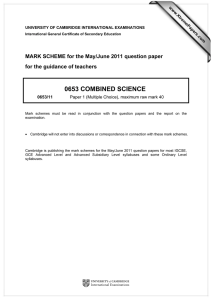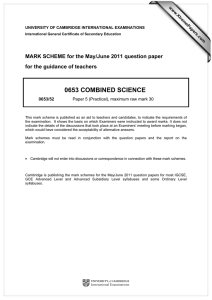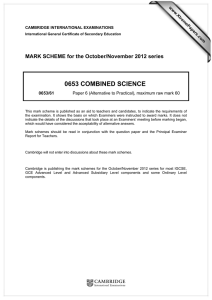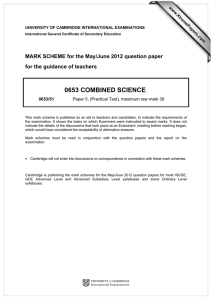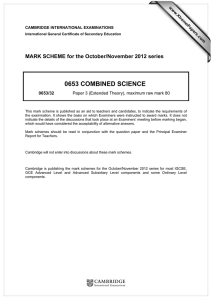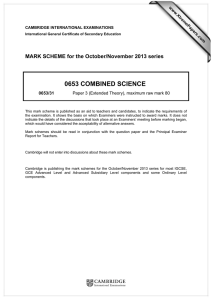0653 COMBINED SCIENCE MARK SCHEME for the October/November 2013 series
advertisement
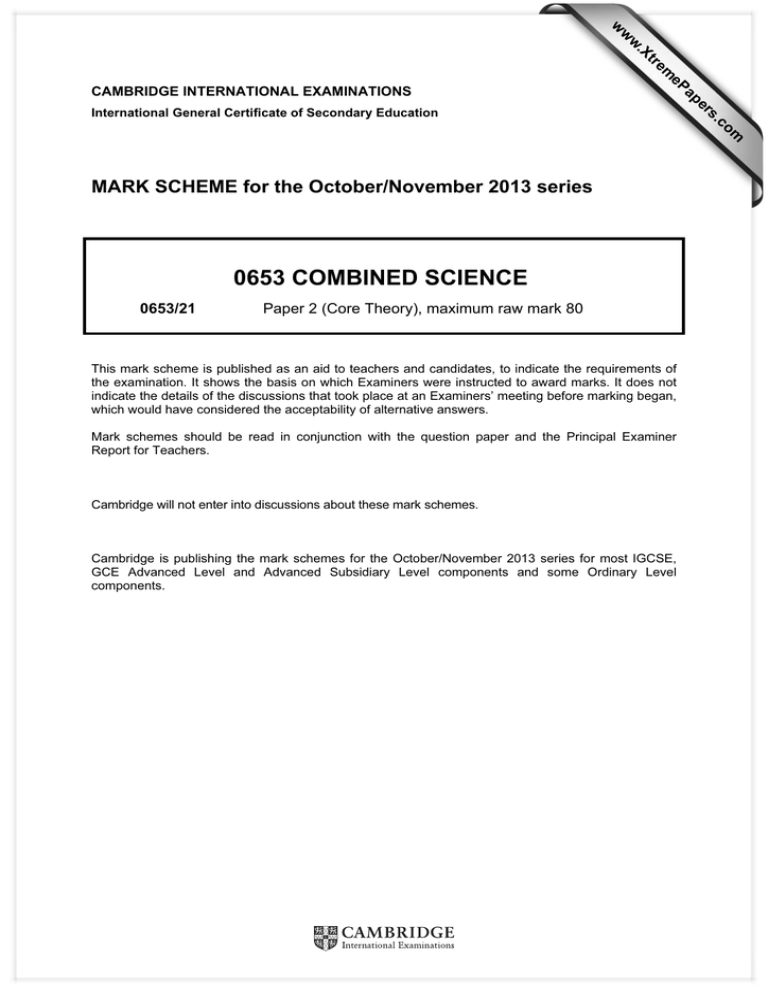
w w ap eP m e tr .X w CAMBRIDGE INTERNATIONAL EXAMINATIONS 0653 COMBINED SCIENCE 0653/21 Paper 2 (Core Theory), maximum raw mark 80 This mark scheme is published as an aid to teachers and candidates, to indicate the requirements of the examination. It shows the basis on which Examiners were instructed to award marks. It does not indicate the details of the discussions that took place at an Examiners’ meeting before marking began, which would have considered the acceptability of alternative answers. Mark schemes should be read in conjunction with the question paper and the Principal Examiner Report for Teachers. Cambridge will not enter into discussions about these mark schemes. Cambridge is publishing the mark schemes for the October/November 2013 series for most IGCSE, GCE Advanced Level and Advanced Subsidiary Level components and some Ordinary Level components. om .c MARK SCHEME for the October/November 2013 series s er International General Certificate of Secondary Education Page 2 1 Mark Scheme IGCSE – October/November 2013 Syllabus 0653 (a) (i) reference to reactivity of elements / compound is more stable ; [1] (ii) element cannot be simplified / decomposed chemically ; element contains just one type of atom ; element is found in Periodic Table ; (or corresponding answers for compound) [max 1] (iii) heat / boil solution ; water evaporates leaving sodium chloride ; leave to evaporate ; (b) Paper 21 [max 2] idea that formula shows the ratio Ca:F particles is 1:2 ; [1] (c) (i) electrolysis ; [1] (ii) bromine is formed ; bromine (vapour) is orange ; bromine evaporates / boils off ; [max 2] [Total: 8] 2 (a) arrow going downwards ; [1] (b) mass = density × volume ; = 1.26 × 0.15 = 0.19 kg ; [2] (c) solid – all particles touching, regular arrangement particles of similar size ; liquid – most particles touching, irregular arrangement particles of similar size ; [2] (d) description S, L or G It cannot flow S It cannot transfer heat by convection S It contains particles which are widely separated G It expands the most when heated G It fills a closed container G It has a fixed volume but not a fixed shape L [2] [Total: 7] © Cambridge International Examinations 2013 Page 3 3 Mark Scheme IGCSE – October/November 2013 Syllabus 0653 (a) (i) substance produced by a gland carried in blood affects activity of target organs destroyed by liver ;; Paper 21 [max 2] (ii) increases heart rate / increases breathing rate / sweating / pupil dilation / increases pulse rate / faster reactions / increases rate of respiration / increase in oxygen to muscles/brain ; accept any correct answer (b) (i) increased then decreased increased more rapidly than it decreased maximum 6.6 units /at 40 minutes quote figures, e.g. returned to normal by 100 minutes ;;; (ii) (blood glucose concentration) did not rise as high maximum 4 units rather than 6.6 units rose more slowly fell more slowly took longer to return to normal ;;; (c) reduces, constipation / bowel cancer / risk of diabetes ; [1] [max 3] [max 3] [1] [Total: 10] 4 (a) (i) Y and Z ; non-metals ; [2] (ii) Z ; it is a noble / inert gas / ref to filled shells in atoms ; (b) (i) Group 1 ; reference to at least one of the proton numbers plotted on graph ; (ii) rubidium ; [2] [2] [1] (c) (i) insoluble substance dissolved / disappeared colour change / coloured substance produced ; (ii) (reactants→) copper sulfate ; + water ; [max 1] [2] [Total: 10] © Cambridge International Examinations 2013 Page 4 5 Mark Scheme IGCSE – October/November 2013 Syllabus 0653 Paper 21 (a) speed = distance/time ; = 3000/30 = 100 km/hr ; [2] (b) (i) 120 km/hr ; [1] (ii) changing speed / going faster / accelerating ; [1] (c) 1,000,000 × 0.10 × 0.70 ; = 70,000 J ; [2] (d) (i) geothermal/tides/hydroelectric/waves/wind/biomass ; [1] (ii) fossil fuels not wasted no CO2 produced ; [max 1] [Total: 8] 6 (a) A (right) atrium ; B (right) ventricle ; [2] (b) contracts ; reduces volume of ventricle ; increases pressure ; [max 2] (c) needs to produce less force ; to push blood into ventricle ; not out of the heart ; [max 2] (d) uses more energy ; energy obtained by respiration ; respiration uses oxygen ; [max 2] [Total: 8] © Cambridge International Examinations 2013 Page 5 7 Mark Scheme IGCSE – October/November 2013 (a) (i) petroleum / crude oil / natural gas ; Syllabus 0653 Paper 21 [1] (ii) compound of hydrogen and carbon only ; [1] (iii) C2H4 + Br2 ; → C2H4Br2 ; (allow Br2 anywhere in product formula) [2] (b) (i) the temperature (inside kiln) is high / is 950 °C ; exothermic means the reaction releases heat (energy) ; (ii) carbon dioxide carbon monoxide water (vapour) two of the above with produced by combustion of propane / hydrocarbons ;;; (ignore refs to complete combustion) [2] [max 3] [Total: 9] 8 (a) Correct symbol for open switch resistor voltmeter V fuse [2] (b) damaged insulation/bare wires ; danger of electrocution ; [2] (c) (i) 0.5 A 0.5 A ; (need both) [1] (ii) R = R1 + R2 ; = 10 Ω ; [2] [Total : 7] © Cambridge International Examinations 2013 Page 6 9 Mark Scheme IGCSE – October/November 2013 (a) (i) controls what enters / leaves the cell ; Syllabus 0653 Paper 21 [1] (ii) cell wall ; chloroplast ; large permanent vacuole ; vacuole membrane ; [max 2] (iii) takes place in chloroplasts ; chlorophyll absorbs / traps, sunlight / energy from sunlight ; water combines with carbon dioxide ; produces oxygen and glucose / sugar / carbohydrate ; [max3] (b) extinction ; soil erosion ; flooding ; build up of carbon dioxide ; drought ; increase in global warming ; [max 3] [Total: 9] 10 (a) (i) infrared ; [1] (ii) microwaves ; [1] (b) 100 m ; 1.5 m ; [2] [Total: 4] © Cambridge International Examinations 2013
